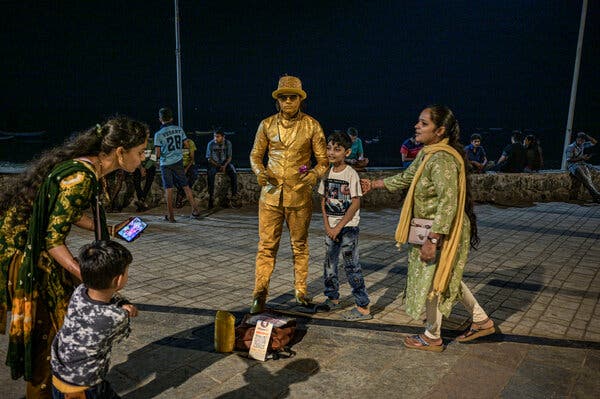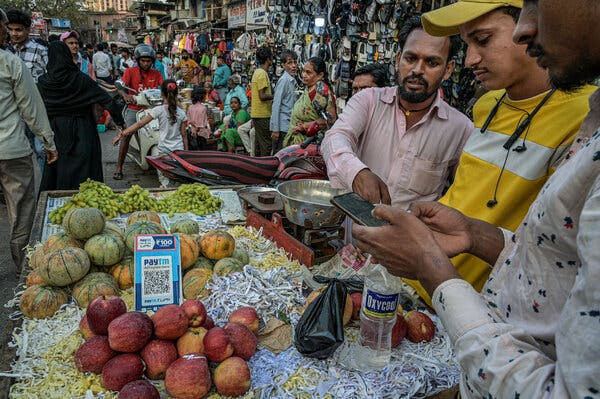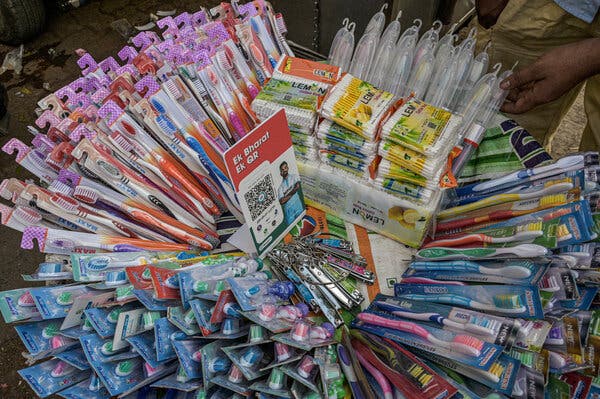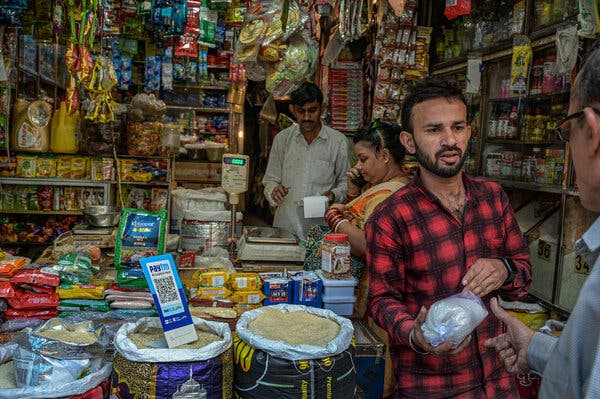How to install the app on iOS
Follow along with the video below to see how to install our site as a web app on your home screen.
Note: This feature may not be available in some browsers.
You are using an out of date browser. It may not display this or other websites correctly.
You should upgrade or use an alternative browser.
You should upgrade or use an alternative browser.
India’s homegrown instant payment system has remade commerce and pulled millions into the formal economy
- Thread starter Suriya
- Start date
there are large societies with similar issuesQR codes for payment were widely used in china. There is nothing wrong in copying through. Indian rbi studies china like anything.
This is a good idea. Regulation is the way forward.Where Digital Payments, Even for a 10-Cent Chai, Are Colossal in Scale
India’s homegrown instant payment system has remade commerce and pulled millions into the formal economy.
A QR code at a roadside food stall in Mumbai, India, allows customers to make instant payments with their phones.Credit...Atul Loke for The New York Times

By Mujib Mashal and Hari Kumar
Reporting from New Delhi, Mumbai and Kerala in India
March 1, 2023
The little QR code is ubiquitous across India’s vastness.
You find it pasted on a tree next to a roadside barber, propped on the pile of embroidery sold by female weavers, sticking out of a mound of freshly roasted peanuts on a snack cart. A beachside performer in Mumbai places it on his donations can before beginning his robot act; a Delhi beggar flashes it through your car’s window when you plead that you have no cash.
The codes connect hundreds of millions of people in an instant payment system that has revolutionized Indian commerce. Billions of mobile app transactions — a volume dwarfing anything in the West — course each month through a homegrown digital network that has made business easier and brought large numbers of Indians into the formal economy.
The scan-and-pay system is one pillar of what the country’s prime minister, Narendra Modi, has championed as “digital public infrastructure,” with a foundation laid by the government. It has made daily life more convenient, expanded banking services like credit and savings to millions more Indians, and extended the reach of government programs and tax collection.
With this network, India has shown on a previously unseen scale how rapid technological innovation can have a leapfrog effect for developing nations, spurring economic growth even as physical infrastructure lags. It is a public-private model that India wants to export as it fashions itself as an incubator of ideas that can lift up the world’s poorer nations.
Image

A street performer with a code for donations.Credit...Atul Loke for The New York Times
“Our digital payments ecosystem has been developed as a free public good,” Mr. Modi said on Friday to finance ministers from the Group of 20, which India is hosting this year. “This has radically transformed governance, financial inclusion and ease of living in India.”
In simple terms, Indian officials describe the digital infrastructure as a set of “rail tracks,” laid by the government, on top of which innovation can happen at low cost.
At its heart has been a robust campaign to deliver every citizen a unique identification number, called the Aadhaar. The initiative, begun in 2009 under Mr. Modi’s predecessor, Manmohan Singh, was pushed forward by Mr. Modi after overcoming years of legal challenges over privacy concerns.
The government says about 99 percent of adults now have a biometric identification number, with more than 1.3 billion IDs issued in all.

Digital payments have become common for even the smallest purchases.Credit...Atul Loke for The New York Times
Nandan Nilekani, a co-founder of the information technology giant Infosys who has been involved in India’s digital identification efforts since their early days, said the country could make a technological leap because it had little legacy digital infrastructure in place. “India was able to develop afresh with a clean slate,” he said.
The IDs ease the creation of bank accounts and are the foundation of the instant payment system, known as the Unified Payments Interface. The platform, an initiative of India’s central bank that is run by a nonprofit organization, offers services from hundreds of banks and dozens of mobile payment apps, with no transaction fees.
In January, about eight billion transactions worth nearly $200 billion were carried out on the U.P.I., according to Dilip Asbe, the managing director of the National Payments Corporation of India, which oversees the platform.

Dilip Asbe, the managing director of the National Payments Corporation of India, which oversees the digital payments platform, at its offices in Mumbai.Credit...Atul Loke for The New York Times
The value of instant digital transactions in India last year was far more than in the United States, Britain, Germany and France. “Combine the four and multiply by four — it is more than that,” as one Indian cabinet minister, Ashwini Vaishnaw, told the World Economic Forum in January.
The system has grown rapidly and is now used by close to 300 million individuals and 50 million merchants, Mr. Asbe said. Digital payments are being made for even the smallest of transactions, with nearly 50 percent classified as small or micro payments: 10 cents for a cup of milk chai or $2 for a bag of fresh vegetables. That is a significant behavioral shift in what has long been a cash-driven economy.
ADVERTISEMENT
Continue reading the main story
One impetus for the move away from cash and toward digital payments was Mr. Modi’s 2016 decision to remove all large-denomination currency from the market. Promoted as an effort to eradicate black money in politics, the shock devastated small businesses that ran on cash.
Image

The QR codes have made life easier for millions.Credit...Atul Loke for The New York Times
Reliance on the digital infrastructure deepened during the pandemic, as the government used the ID numbers to manage the world’s largest vaccination drive and deliver financial aid.
As the system has become embedded in Indian life, the concerns over data privacy have not fully receded, even after Supreme Court rulings governing its use. Some worry that the sharp erosion of checks on government power under the strongman rule of Mr. Modi could open the door to abuses of the central identity database. With India pushing its model abroad, including in countries lacking strong legal safeguards, these concerns will follow.
Amitabh Kant, one of India’s top coordinators for the Group of 20 events, said the government had struck the right balance between privacy and innovation. “We said that the data belongs to the individual and that he has the right to give consent for every transaction that he undertakes,” he said.
Image

The digital payments system has brought many people into the formal economy.Credit...Atul Loke for The New York Times
In two dozen interviews across villages, small towns and cities, a varied picture of digital payments emerged. In a pair of village shops in the northern state of Uttar Pradesh, they made up about 10 percent of daily sales; in the busier markets of Delhi, that number could be a quarter or half.
ADVERTISEMENT
Continue reading the main story
Even in sectors that have not yet adopted digital payments, like the fishing industry in the southern state of Kerala, the basic pillars of the digital infrastructure — the identity number, bank accounts and mobile phone apps — made it easier to deliver services.
In markets where digital payments have taken hold, the raw excitement of the newly converted is palpable. App companies are working to ensure ease of use across a wide spectrum of digital literacy. Merchants on the same sidewalk help one another. And because this is technology we are talking about, children come to the aid of parents.
Image

Billions of transactions take place each month.Credit...Atul Loke for The New York Times

Small voice boxes provided by payment apps are a fixture at snack carts and tea stalls, where vendors are too busy to check phone messages after every small transaction. A Siri-like voice declares how much money was instantly received with each payment by QR code. This has helped bridge mistrust among merchants long used to cash transactions.
Merchants like the cobbler and the ice cream seller at a central Delhi market who do not have their own QR code simply borrow their neighbor’s. It’s the digital version of: I don’t have change, but will make it work with the help of my neighbor.
“I used to prefer cash,” said Rajesh Kumar Srivastva, an auto-rickshaw driver in Delhi. “But I learned the benefits of this during the lockdown.”
Before the pandemic, Mr. Srivastva pasted a QR code on the inside of his rickshaw, but since only a quarter of his payments were digital, they remained an afterthought.
Image

The digital payments have taken hold in what has been a cash-based economy.Credit...Atul Loke for The New York Times
Just before the 2020 lockdown, Mr. Srivastva paid a hefty electricity bill and two installments of the loan on his vehicle, depleting the cash at home.
His cash earnings usually were not enough to justify travels for bank deposits. But his wife urged him to check the account linked to the digital payments. Unable to figure out his balance at an A.T.M., he returned with his daughter, a 20-year-old civil engineering student.
First, his daughter withdrew 5,000 rupees, roughly $60.
“She checked again, and said, ‘Papa, there is 45,000 more left,’” Mr. Srivastva said, before breaking into a big smile. “I loved it!”

Where Digital Payments, Even for a 10-Cent Chai, Are Colossal in Scale
India’s homegrown instant payment system has remade commerce and pulled millions into the formal economy.www.nytimes.com
I don't think most Indians have that idea about ID card. Infact India was very late to have something like a national ID card. Before that a Passport, Ration card, or Drivers licence was your ID card.Most countries have had growth of digital payments. You did not need 2016 money ban.
Indians like to think Pakistan does not have a biometric identity card etc.
UPI is a boon for me. I don't carry much cash nowadays just some for the offhand chance when bank servers are busy which happens like very rarely (I use ICICI).
Scanning and paying is much better than using physical cash imo. I don't even use atm card now lol, upi + netbanking is the way to go.
But I'd agree that cash does come in clutch sometimes.
Scanning and paying is much better than using physical cash imo. I don't even use atm card now lol, upi + netbanking is the way to go.
But I'd agree that cash does come in clutch sometimes.
kris
SENIOR MEMBER

- Joined
- Dec 3, 2016
- Messages
- 2,565
- Reaction score
- -12
- Country
- Location
Points in order will help.Now the Indian government knows where and on what these idiots spend their money.
Modi is trying hard to end paper currency and bring in digital currency.
The BJP while in opposition opposed Congress's Aadhar project. But when Modi came to power, he made Aadhar mandatory and destroyed the Right to Privacy.
Way things are going. Modi will introduce Social Credit System after 2024 election.
Andh Bhakts have lost their ability to distinguish good from bad.
1) Making economy formal is good for poor people in general. The haves will pay more taxes.
2) overall corruption will go down
3) never heard BJP opposing AADHAR
kmc_chacko
FULL MEMBER

- Joined
- Dec 13, 2008
- Messages
- 1,076
- Reaction score
- -1
- Country
- Location
UPI is a boon for me. I don't carry much cash nowadays just some for the offhand chance when bank servers are busy which happens like very rarely (I use ICICI).
Scanning and paying is much better than using physical cash imo. I don't even use atm card now lol, upi + netbanking is the way to go.
But I'd agree that cash does come in clutch sometimes.
Last week I travelled 600 kms through Bus, Railway, Metro and even Auto and spent only Rs 60 /- in cash and it seems India moved very fast since entry of Reliance Jio 4G.
iamnobody
BANNED

- Joined
- Feb 28, 2023
- Messages
- 1,360
- Reaction score
- -12
- Country
- Location
1) Why does Modi let Jain, Gujarati and Marwadi Businessmen evade taxes, sell them land at throwaway price, gift them government contracts , manipulate stock value, let them park their black money in foreign banks, etc?Points in order will help.
1) Making economy formal is good for poor people in general. The haves will pay more taxes.
2) overall corruption will go down
3) never heard BJP opposing AADHAR
2) No. The rich crooks will game the system as usual. The already struggling Middle class will find it impossible to evade taxes.
3)

BJP attacks Aadhaar scheme, says it violates right to privacy
The UIDAI, which has run into controversies recently, came under fresh attack with the BJP alleging that the Aadhaar card issued by it to citizens as a unique identification does not have Parliament’s approval and has been rejected by one of the key committees of the House.
Zhukov
SENIOR MEMBER

- Joined
- Oct 26, 2009
- Messages
- 3,725
- Reaction score
- 9
- Country
- Location
In Pakistan Private telecom companies and banking institutions started similar initiatives like. But government did nothing to help. No promotion, no Tax incentive, no incentives.
Most prominent of them were Jazzcash and Easypaisa. Dont know whats the situation now.
Most prominent of them were Jazzcash and Easypaisa. Dont know whats the situation now.
Borderlands
FULL MEMBER

- Joined
- Nov 11, 2022
- Messages
- 126
- Reaction score
- 0
- Country
- Location
India is a good case study for this. It all started with demonetization that took place in India in 2016. This incentivized people to start paying digitally instead of paying with cash. In 2016, a payment digitization experiment was being conducted in an Indian village. When this demonetization happened, this village was unaffected by it since cash wasn't being used over there. I learned about this from The Future of Payment Technologies course which is offered by the University of Michigan.
You are right. Befor demonetisation, most peoples were not using UPI. While i did used it before, it become more predominant during 2016 when everyone started using it. Online payment makes it impossible to bypass GST and other taxes. So it also forced retailers to adhere to tax regimes.
Another factor is the wide availability of cheep and reliable internet. Cheep 4G brought almost everyone, including old peoples to digital world.
Thevilone
BANNED

- Joined
- Feb 27, 2023
- Messages
- 145
- Reaction score
- -6
- Country
- Location
I remember I used to withdraw cash from ATM almost every week, now I withdraw cash once in many months. Digitization will catch up even faster now that India has it's own Satellite system. These can be used both for Navigation and internet. Rural location will benefit the most.By started with demonetization, I was referring to the incentivization for the adoption of digital payment methods by people. Of course, the digitization plan had to start much earlier than this.
Off topic, what are mobile internet charges in Pakistan? Internet is such an underrated part of infrastructure.
Demonetization was not just about promoting digital currency. It was primarily aimed at corruption, hoarding, tax-evasion, black market and terrorists.Most countries have had growth of digital payments. You did not need 2016 money ban.
Indians like to think Pakistan does not have a biometric identity card etc.
Bureaucrats and politicians who had stuffed away crores in cash in lockers or hidden locations suddenly found their cash useless and could not deposit it into their bank accounts due to fear of getting caught. https://economictimes.indiatimes.co...es-returned/articleshow/65589904.cms?from=mdr 0.7% which is approx 12,000 crore Rupees worth of currency was never exchanged for new currency. Which means 12000 crores of black money was simply wiped off.
Once India decided to do it, it did it right. My Aadhar card connects to my health insurance, driving license, passport, pretty much everything. I renewed my passport online without having to take out a single printout, everything is connected to my Aadhar which is connected to my Digilocker. https://www.gadgetsnow.com/faqs/dig...ore-queries-answered/articleshow/97914951.cmsI don't think most Indians have that idea about ID card. Infact India was very late to have something like a national ID card. Before that a Passport, Ration card, or Drivers licence was your ID card.
Everything from my school certificate to my birth certificate to covid certificate, all vehicle related documents, income tax details are all available on my phone in DIgilocker app which i considered equivalent to original for all purposes.
Last edited:
_NOBODY_
SENIOR MEMBER

- Joined
- Jan 6, 2016
- Messages
- 3,327
- Reaction score
- 4
- Country
- Location
Now we have startups that are causing massive disruption in Pakistan. Banks have also now started getting their sh*t together after seeing what these startups are doing.In Pakistan Private telecom companies and banking institutions started similar initiatives like. But government did nothing to help. No promotion, no Tax incentive, no incentives.
Most prominent of them were Jazzcash and Easypaisa. Dont know whats the situation now.
Zhukov
SENIOR MEMBER

- Joined
- Oct 26, 2009
- Messages
- 3,725
- Reaction score
- 9
- Country
- Location
Disruption? Clerify please.Now we have startups that are causing massive disruption in Pakistan. Banks have also now started getting their sh*t together after seeing what these startups are doing.
Similar threads
- Replies
- 5
- Views
- 391
- Replies
- 1
- Views
- 520
- Replies
- 1
- Views
- 183
- Replies
- 0
- Views
- 456
- Replies
- 0
- Views
- 171








